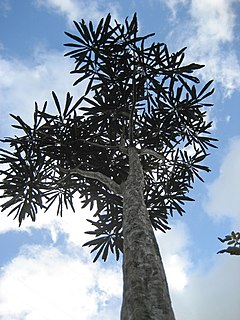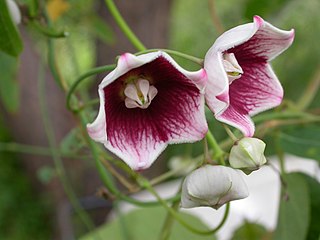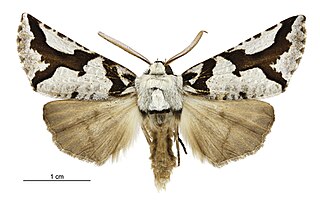
Pseudopanax is a small genus of 12–20 species of evergreen plants, the majority of which are endemic to New Zealand. Flowers of the genus occur in terminal umbels.

Pseudopanax arboreus or five finger, is a New Zealand native tree belonging to the family Araliaceae. It is one of New Zealand's more common native trees, being found widely in bush, scrub and gardens throughout both islands. The compound leaves with five to seven leaflets, hence the common name, are very characteristic of the tree and easily recognized.

Pseudopanax crassifolius, the horoeka or lancewood, is a New Zealand native tree belonging to the family Araliaceae. It is found throughout New Zealand from sea level up to about 750 m. The juvenile form, which lasts for between 15 and 20 years, is very easily recognized. The leaves are stiff and leathery with a prominent central rib, about 1 cm wide and up to 1 m long with irregular teeth, all growing downwards from a central stem. The young trunk has characteristic vertical swollen ridges. As the tree gets older the stem begins to branch, producing a bushy top, and the leaves become wider and shorter, losing their teeth. It is only when the tree is mature that it adopts a typical tree shape.

The yellow weaver, Parapercis gilliesii, is a sandperch, a species of marine fish in the genus Parapercis found only around New Zealand.

Meryta is a genus in the flowering plant family Araliaceae. There are 28 described species in the genus, all small, resinous trees of the subtropical and tropical Pacific Ocean, characterized by huge, simple leaves and a dioecious sexual system, a unique combination in Araliaceae. Meryta has its center of diversity in New Caledonia. Phylogenetic analyses have placed Meryta in one of the three major clades of the Araliaciae, the Polyscias-Pseudopanax group, and more specifically in the Pacific Schefflera subclade.

Aralioideae is a subfamily of flowering plants contains around 50 recognized genera. These include the genus Panax, to which ginseng belongs. Other notable species are the Angelica-tree, the devil's club, or common ivy.

Schefflera digitata, the patē, seven-finger, or umbrella tree, is a tree endemic to New Zealand belonging to the family Araliaceae. The Māori name is patē or patatē. It occurs in lowland to lower montane forests from sea level to 1200 m in the North Island, South Island, and Stewart Island, covering a latitudinal range from 34°S to 47°S. It prefers damp, shady parts of the forest and is common along stream banks and on shady forest roadsides. It is the only New Zealand representative of the genus Schefflera, which has 200 species of shrubs and small trees in the tropics and subtropics.
Polyscias scopoliae is a species of plant in the family Araliaceae. It is endemic to New Caledonia.

Sarcostemma is a genus of flowering plants in the dogbane family, Apocynaceae, first described as a genus in 1810. The name is derived from the Greek words σαρκὸς (sarkos), meaning "flesh," and στέμμα (stemma), meaning "garland". Members of the genus are known generally as climbing milkweeds or caustic bushes. They are found across Africa and tropical Asia, in Australia, and in parts of North America. These plants are perennial flowering shrubs with trailing vines or lianas. They are often adapted to heat and/or desert conditions. Some have few or no leaves and photosynthesize in the tissues of the green stems. The soft stems are filled with a milky white latex that is poisonous and caustic in some species. The flowers have a ring of thick tissue at the base which extends into hollow spherical appendages within the flower corolla.
Salvia cuspidata is a perennial shrub native to the Andes mountains in Bolivia, Chile, and Peru, growing at elevations up to 10,000 ft (3,000 m).
P. linearis may refer to:
Tillandsia gilliesii is a species in the genus Tillandsia. This species is native to Bolivia.
Acrocercops aethalota is a species of moth of the family Gracillariidae, known from New Zealand. The hostplant for the species is Pseudopanax arboreus.
Pterophorus monospilalis is a moth of the family Pterophoridae. It is found in New Zealand, where it is known from the North and South islands and Stewart Island.
John Gillies (1792–1834) was a Scottish naval surgeon who later became an explorer and botanist, travelling extensively in South America. Educated at the University of Edinburgh, he served in the Royal Navy during the Napoleonic Wars. Afflicted by tuberculosis, Gillies left the UK aged 28 for South America in the hope that the climate would improve his fragile health. He spent eight years there, mostly in Argentina, surviving wars, civil unrest, and chronic ill health, sending numerous plants to Hooker at the Royal Botanic Gardens Kew before returning in 1828. He died aged 42 at Edinburgh on 24 November 1834, his remains interred at Calton.

Declana atronivea, commonly called the North Island lichen or North Island zebra moth, is a moth of the family Geometridae. It is endemic to New Zealand. It is one of only two insect species with asymmetrical wing markings.
Paleopanax is an extinct genus of flowering plant in the Ginseng family, Araliaceae, containing the single species Paleopanax oregonensis. The species is solely known from the middle Eocene sediments exposed in north central Oregon and was first described from a series of isolated fossil fruits in siltstones.

Oxystelma is a genus of flowering plants of the family Apocynaceae, first described as a genus in 1810. It is native to Africa and Asia.
- Oxystelma bornouenseR.Br. - tropical Africa
- Oxystelma esculentum(L.f.) Sm. - China, Indochina, Indian Subcontinent, Middle East, NE Africa
Raukaua gunnii is a species of plant in the family Araliaceae native to Tasmania. It was previously known as Pseudopanax gunnii, but was found not to be closely related to the core members of Pseudopanax.

Declana egregia, commonly called the South Island lichen moth or zebra lichen moth, is a moth in the family Geometridae, endemic to New Zealand. This species was first described by entomologists Baron Cajetan von Felder and Alois Friedrich Rogenhofer in 1875 under the name Chlenias egregia.












